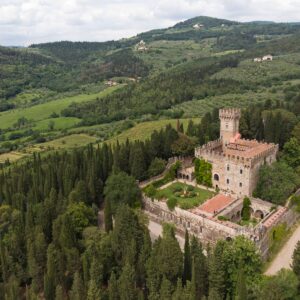Out of the trip came my book: The Serpent & the Cross.

The great Mille Miglia (Thousand Miles) road race was held twenty four times 1927-1957 with a gap during World War II. The race continues today as an historic classic car event. https://1000miglia.it My love of motor racing, and Italy can be argued to be its spiritual home, began long before I could drive legally. Its genesis came out of a Jon Cleary battered paperback of the Australian novelist’s 1957 book “The Green Helmet”, I still have a copy on my bookshelf. The story of a private entry special, the Wizard powered by a Jaguar XK 140 3.4 engine, into the Mille Miglia, that of course wins the race. The car in my mind resembles the Lister Knobbly produced 1957-1959, reproductions are still made today. https://www.lister.com I promised myself one day I would drive the route. Thirty-five years later I did.
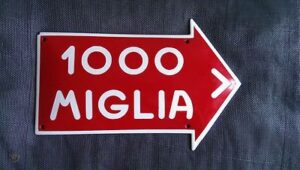

For many years I was a Jaguar enthusiast owning six different models. As far as Italian cars were concerned, two Fiats had been second cars and there had been a brief, if troublesome affair, with a Lancia Fulvia. This was my total experience, although I had always admired Italian cars from afar.
An Alfa Romeo had always been on the list and finally the 156 hooked me, I had wanted to drive one ever since it was voted European Car of the year in 1998. On a holiday to Lake Garda in 2003 we hired a 156 and decided to drive the Mille Miglia route, stopping at points of interest en route; it would also be a good test of the car, a thousand mile road test over all sorts of roads. There might even be a travel book in the trip. By then I had been writing for many years, mainly articles on military history.
So duly my wife and I arrived at the Hotel Broglia in Sirmione on Lake Garda. Spending a few days on the lake and visiting the opera at Verona to see Aida. https://wwww.hotelbroglia.it Finally the Alfa was delivered, a blue 156 BB 881 WN, the only downer, it was a diesel. There would be no music from a twin spark engine. Disappointed I felt all Alfa Romeos great designers frowning down on me “you might as well drive a tractor”, but Nicola Romeo saved his company from bankruptcy during World War One, by making tractors, pumps and parts for railway engines.

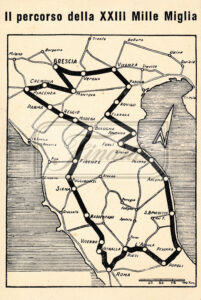
The chosen route was not unlike the figure of eight, with Bologna at the centre, run in 1933, and won by Nuvolari in his Alfa Romeo 8c-2300 entered by Scuderia Ferrari. Covering the route of 1,022 miles in 15 hours 11 minutes at a speed of 67.9mph, truly remarkable given the condition of the roads in those days. The year 1933 would later become important to me.
We set off early from Sirmione for Brescia. There we visited the graffiti covered Piazza della Vittorio in all its gothic fascist splendour where the cars start and finish the Mille Miglia. The town had little else to offer. Heading west on the Via Mille Miglia we took the 236 toward Mantua across flat countryside interspaced with stands of poplar and eucalyptus trees.
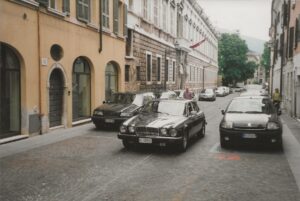
South of the Guidizzolo village was the area where in the 1957 race, de Portago’s works Ferrari, which was lying third, somersaulted down the road when the left front Englebert tyre blew out. Portago’s co-driver Ed Nelson, and nine spectators, including five children were killed. There was outrage in Italy and the accident spelled the end of the Mille Miglia as a race. Enzo Ferrari even faced criminal charges before he and his company were exonerated.
Mantua’s main claim to fame is that Verdi’s opera Rigoletto is set there. However we had come to see the Tazio Nuvolari museum which was closed on a Tuesday. Still we had coffee and some good pastries, and moved on east to Castel D’Ario where Nuvolari was born.
The 12 took us south across the Po River and plain of the same name. On this flat countryside the 156 gobbled up the miles. Occasionally our speed dropped as we entered dense fog banks often encountered on this plain.
Nearing Modena the weather cleared, it was bright and sunny, even so we missed the turning for Maranello, home of Ferrari, and had to detour around the ring road to find it. We swapped over driving and map reading to avoid arguments. I managed to get us to Maranello but could not find the museum. Still a kindly Italian man drew us a map to find the museum complete with flashing traffic lights which took us right there.
Naturally being petrol heads we spent more time in the Galleria of Ferrari and the sights of the town than we intended. https://www.ferrari.com
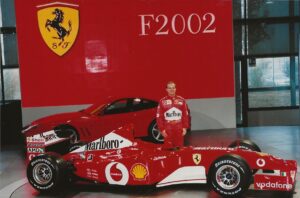
After a hurried lunch we took the 12 toward Lucca over the Abetone Pass at 1388 metres. Here the 156’s diesel engine began to show its origins which meant much use of second gear, even first on some hairpins as we climbed over the Apennine Mountains. At the Abetone Pass it began raining with heavy mist, typical Mille Miglia weather.
Descending from the pass the weather rapidly improved. In a lay-by we stopped for a break where we watched several mushroom pickers disappearing into the woods with baskets.
At Lucca we took time to visit the town, a charming walled town, far more pleasant than crowded Pisa, the highlight a visit to the Puccini House. We filled the 156 but opening the filler flap it promptly fell off. The attendant and I managed to get it back on and he even gave my tip back.
By then it was well past five so on the autostrada skirting Florence and heading toward Siena on the 2, the 156 was up toward the limit on the rev counter. Still we raced through the Tuscan landscape past vineyards, fields of sunflowers, and hill top towns turned honey gold by the sinking sun.
Well south of Siena we stopped for the night at a motel having by then joined the A1 auto strada. The services restaurant was wonderful, the tiramisu out of this world.
It rained heavily during the night. The truckers began blowing their horns at 3am to wake their oppo’s, waking us in the process. Thus we set off early before six.
A few miles short of Rome we turned west to Terni not wishing to go into the eternal city on this occasion. At Terni we headed north on the return toward Perugia. On the shores of Lake Trasimeno, which was shrouded by mist and rain we stopped at Passignana for breakfast. This was where Hannibal’s Carthaginian Army gave the Romans a good thrashing in 217 B.C; but he never got to Rome either. There was little to see so we hurried on trying to leave the dreary weather behind.
It did make me marvel how the crews of the open cars in the race managed in such weather. Stirling Moss and Denis Jenkinson in their Mercedes 300 SL completed the course in ten hours seven minutes an average speed of 97.99mph in 1955, still the record. On that run the conditions were hot. Perhaps more remarkable was Alberto Ascari’s win in a Lancia the year before, which he ran on his own and in heavy rain.
The weather brightened as we ran back toward Florence, although our speed was down, often stuck behind heavy trucks grinding up steep hills. We filled the 156 for the run home having covered 870km.
A few miles short of Florence we turned east onto the 67 for Forli. I had noticed in the Rough Guide that at Predappio Benito Mussolini was buried. Some curious morbid interest drew me to the town and it was on the route.
The 156 was happier here descending toward the sea, away from the endless gear changing on the more hilly sections, although the gear change was clean and clutch light.
Much of Alfa Romeo’s success on the race tracks of the 1930’s was partly due to the Fascist Government funding, behind which was Benito Mussolini who wanted a clear demonstration of Italian engineering supremacy. Indeed, even today among Italians, they have mixed views on the legacy of Il Duce.
Predappio was a strange town which we reached about 12.30. In the centre were some fascist souvenir shops. The towns’ public toilets were terrible and covered in what looked like anti-fascist graffiti.
The Mussolini family crypt was in the town cemetery on the outskirts. The entrance to the crypt was in an imposing building. Entering through the door led to a whitewashed room with a single chair, in the corner was an entrance where a spiral staircase led down into the burial chamber. Bravely I sent the Wife down first in case there were any harpies down there. The chamber was well lit, a bust of Benito Mussolini on his vault, there was even a visitors book, and a young Italian couple came down after us. In fact there was a steady if sparse trickle of visitors.
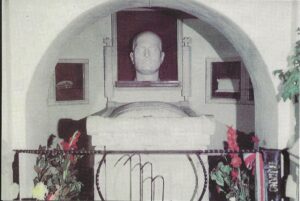
Back outside we came across an old man hurrying into the cemetery wearing a black silk shirt with a large gold crucifix hanging at his neck. I thought at first he was a priest. He became quite animated. We began to wonder if we had broken some rules. Finally putting two fingers against his arm at last we got it, the crypt was open until 2pm; he thought we had just arrived. He must have been an old fascist with a black shirt. Some sort of guardian of the tomb.
On the S9 at Forli we headed north, had a quick look at the Imola race track, and at Bologna joined the A1. Time was pressing, instead of heading for Ferrara we continued onto Modena and then the A22 to Mantua. We stopped there again thinking, who knows; perhaps the Nuvolari Museum would be open this time. No such luck, I was sure the clown Rigoletto was laughing at us “not you again”. Even the Nuvolari Bar was closed. However, we did find a bust to the great driver in a park.

From Mantua with the sun sinking toward the west we headed for Verona and then on to Sirmione arriving back at the hotel Broglia in time for dinner.
We had covered 1,475km even with getting lost several times a little short of the 1,597km of the 1957 Mille Miglia route. The 156 had performed well, really well on fuel averaging over 50mpg, and the comfort for a relatively small car was outstanding. OK she had laboured on the mountain roads but then many cars would there.
Two years after the run a silver 156 Lusso 1.8 TS replaced a Jaguar XJ 40 that had driven me mad with troublesome electrics, five other Alfas have followed another 156 2.0 JTS, a 159 TBI, GT 3.2 V6, GTV 3.0 V6 and a Brera TBI 1750 which is still with us, however recently have returned to Jaguar ownership with an S-Type 3.0 SE.
The novel “The Serpent and the Cross” did come out of the trip the title taken from the coat of arms of Milan and the badge of Alfa Romeo where the serpent and cross are reversed. A story largely set in war time Italy. Inspired partly by our journey and the visit to Predappio, also by the entry of the MG team with their K3 cars in the 1933 Mille Miglia that won class honours. The hiding of the Alfetta GP cars at Melzo during the war to prevent the Germans cutting them up for scrap, is part of the story, seen through the eyes of a young Italian Priest of British/Italian lineage and British POW who is used by SOE to infiltrate the Alfa Romeo design centre that are believed to be working on a jet engine for the Nazi’s that is fiction. However British officers being prisoners’ at Campo 12 Castello di Vincigliata near Florence is based on fact, where the hero is a prisoner and helped to escape by the Priest. The book ending on Lake Como with an alternative view of the death of Mussolini and his mistress Claretta Petacci, to find out more you will have to read the book.


The Castello was first owned by the Visdomini family, Lord John Temple Leader came across it in the 18th century, and then a ruin, purchased it and restored the building to its former glory. The Castello is/ was a posh five star hotel.
The Castello Vincigliata used to be open for events but is hard to fathom if it still is as doesn’t seem to have a website. The address is: Castello Vincigliata, Via Vincigliata, 13, 50014 FI, Italy.
